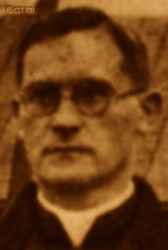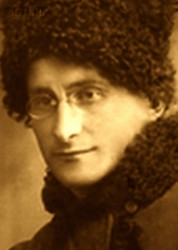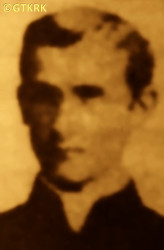Roman Catholic
St Sigismund parish
05-507 Słomczyn
85 Wiślana Str.
Konstancin deanery
Warsaw archdiocese, Poland
full list:
displayClick to display full list

searchClick to search full list by categories
wyświetlKliknij by wyświetlić pełną listę po polsku

szukajKliknij by przeszukać listę wg kategorii po polsku

Martyrology of the clergy — Poland
XX century (1914 – 1989)
personal data
surname
FEDOROWICZ
forename(s)
Ceslav (pl. Czesław)

function
diocesan priest
creed
Latin (Roman Catholic) Church RCmore on
en.wikipedia.org
[access: 2014.09.21]
diocese / province
Polish Catholic Mission in France
Pinsk diocesemore on
en.wikipedia.org
[access: 2013.05.19]
Kamianets diocesemore on
en.wikipedia.org
[access: 2013.05.23]
academic distinctions
Canon Law MA
honorary titles
„Polonia Restituta” Cross — 5th Class, Knight'smore on
„Polonia Restituta” Cross – 5th_Class, Knight's
(10.11.1933)
„Cross of Independence”more on
„Cross of Independence”
(19.12.1933)
date and place
of death
01.06.1940

Bercktoday: Pas‐de‐Calais dep., Hauts‐de‐France reg., France
more on
en.wikipedia.org
[access: 2024.03.19]
alt. dates and places
of death
1939, 05.1940
Sallauminestoday: Pas‐de‐Calais dep., Hauts‐de‐France reg., France
more on
en.wikipedia.org
[access: 2023.03.16]
details of death
After the end of World War I, crossed over the temporary border with reborn Poland and went to Lublin, where completed his master's studies.
In 1920, after the Russian defeat in the Polish–Russian war of 1919‐1921, returned to Podolia, which, as a result of the Treaty of Riga in 1921, remained in Bolshevik Russia.
After the end of Polish–Russian war of 1920 remained in Russia.
For the first time arrested in 1922 in Bila Tserkva by the Russians.
Held in Vinnytsia jail.
Released after few weeks.
In 1926 arrested again by the Russians in Brahilov/Braylov.
Sentenced to 3 years in Russian slave labour concentration camps — Gulag.
In 04.1927 transported to slave labour camps ITL SLON on Solovetsky Islands.
In 1928 moved back to Vinnytsia prison.
After 6 months transferred to Kharkiv (there held in Kholodnaya Gora and Tyuremnaya Str. prisons).
There in 1929 accused of leading in his last Hnivan–Vitovo parish a „counter–revolutionary organisation” and on 13.02.1929 in Vinnytsia sentenced by the Russians to death, commuted to 10 years in prison.
On 01.09.1929 taken to Yaroslav on Volga river prison.
Next in 09.1932 transferred to Butyrki prison in Moscow.
On 15.09.1932 released, exchanged for a Russians spy in Poland and sent to Poland.
After German and Russian invasion of Poland in 09.1939 and start of the World War II perished in shrapnel explosion during German invasion of France started on 10.05.1940.
alt. details of death
According to other sources murdered by Germans.
cause of death
warfare
perpetrators
Germans
sites and events
Ribbentrop‐MolotovClick to display the description, Pius XI's encyclicalsClick to display the description, Moscow (Butyrki)Click to display the description, Jaroslav on Volga riverClick to display the description, ITL SLONClick to display the description, Kharkiv (prison)Click to display the description, Polish‐Russian war of 1919‐1921Click to display the description
date and place
of birth
20.12.1891

alt. dates and places
of birth
12.12.1891, 30.11.1891
presbyter (holy orders)
ordination
15.06.1917

Sankt Petersburgtoday: Saint Petersburg city, Russia
more on
en.wikipedia.org
[access: 2020.07.31]
positions held
c. 1939 – 1940
priest — Sallauminestoday: Pas‐de‐Calais dep., Hauts‐de‐France reg., France
more on
en.wikipedia.org
[access: 2023.03.16] — among Polish emigrants and migrants
from 1937
parish priest — Baranavichytoday: Baranavichy dist., Brest reg., Belarus
more on
en.wikipedia.org
[access: 2022.05.02] ⋄ Our Lady the Queen of Polish Crown RC parish ⋄ Baranavichytoday: Baranavichy dist., Brest reg., Belarus
more on
en.wikipedia.org
[access: 2022.05.02] RC deanery
1933 – 1937
parish priest — Staroelnyatoday: Danilovichi ssov., Dzyatlava dist., Grodno reg., Belarus
more on
be.wikipedia.org
[access: 2022.08.05] ⋄ Holy Trinity RC parish ⋄ Navahrudaktoday: Navahrudak dist., Grodno reg., Belarus
more on
en.wikipedia.org
[access: 2021.07.04] RC deanery — acting („ad interim”)
1933 – 1937
administrator — Valevkatoday: Valevka ssov., Navahrudak dist., Grodno reg., Belarus
more on
be.wikipedia.org
[access: 2022.07.21] ⋄ RC parish ⋄ Navahrudaktoday: Navahrudak dist., Grodno reg., Belarus
more on
en.wikipedia.org
[access: 2021.07.04] RC deanery — acting („ad interim”)
1933 – 1937
rector — Lopushnotoday: Danilovichi ssov., Dzyatlava dist., Grodno reg., Belarus
more on
be.wikipedia.org
[access: 2023.01.18] ⋄ St Therese RC church ⋄ Holy Trinity RC parish ⋄ Navahrudaktoday: Navahrudak dist., Grodno reg., Belarus
more on
en.wikipedia.org
[access: 2021.07.04] RC deanery — acting („ad interim”)
c. 1933
parish priest — Pruzhanytoday: Pruzhany urban ssov., Pruzhany dist., Brest reg., Belarus
more on
en.wikipedia.org
[access: 2020.11.13] ⋄ Assumption of the Blessed Virgin Mary RC parish ⋄ Pruzhanytoday: Pruzhany urban ssov., Pruzhany dist., Brest reg., Belarus
more on
en.wikipedia.org
[access: 2020.11.13] RC deanery — prob.
1925 – 1926
priest — Hnivan‐Vitavaparish seat name
today: Hnivan, Hnivan urban hrom., Vinnytsia rai., Vinnytsia obl., Ukraine
more on
en.wikipedia.org
[access: 2021.09.17] ⋄ St Joseph Spouse of the Blessed Virgin Mary RC parish ⋄ Vinnytsiatoday: Vinnytsia urban hrom., Vinnytsia rai., Vinnytsia obl., Ukraine
more on
en.wikipedia.org
[access: 2021.09.17] RC deanery
from c. 1923
parish priest — Brahilovtoday: Brailiv, Brailiv hrom., Zhmerynka rai., Vinnytsia obl., Ukraine
more on
en.wikipedia.org
[access: 2023.03.02] ⋄ Holy Trinity RC parish ⋄ Vinnytsiatoday: Vinnytsia urban hrom., Vinnytsia rai., Vinnytsia obl., Ukraine
more on
en.wikipedia.org
[access: 2021.09.17] RC deanery
1921 – 1923
dean — Lityntoday: Lityn hrom., Vinnytsia rai., Vinnytsia obl., Ukraine
more on
en.wikipedia.org
[access: 2020.11.27] RC deanery
priest — Pykivtoday: Pykiv hrom., Khmilnyk rai., Vinnytsia obl., Ukraine
more on
uk.wikipedia.org
[access: 2023.03.02] ⋄ Holy Trinity RC parish ⋄ Vinnytsiatoday: Vinnytsia urban hrom., Vinnytsia rai., Vinnytsia obl., Ukraine
more on
en.wikipedia.org
[access: 2021.09.17] RC deanery
priest — Viitivtsitoday: Viitivtsi hrom., Khmilnyk rai., Vinnytsia obl., Ukraine
more on
uk.wikipedia.org
[access: 2022.08.05] ⋄ RC chapel ⋄ Kumanivtsytoday: Khmilnyk urban hrom., Khmilnyk rai., Vinnytsia obl., Ukraine
more on
uk.wikipedia.org
[access: 2023.03.02], St Ivo RC parish ⋄ Lityntoday: Lityn hrom., Vinnytsia rai., Vinnytsia obl., Ukraine
more on
en.wikipedia.org
[access: 2020.11.27] RC deanery
till 1921
dean — Mohyliv‐Podilskyitoday: Mohyliv‐Podilskyi urban hrom., Mohyliv‐Podilskyi rai., Vinnytsia obl., Ukraine
more on
en.wikipedia.org
[access: 2021.09.17] RC deanery
priest — Snitkivtoday: Murovani Kurylivtsi hrom., Mohyliv‐Podilskyi rai., Vinnytsia obl., Ukraine
more on
uk.wikipedia.org
[access: 2023.03.02] ⋄ Immaculate Conception of the Blessed Virgin Mary RC parish ⋄ Mohyliv‐Podilskyitoday: Mohyliv‐Podilskyi urban hrom., Mohyliv‐Podilskyi rai., Vinnytsia obl., Ukraine
more on
en.wikipedia.org
[access: 2021.09.17] RC deanery
from 1920
defender of the marriage bond — Kamyanets‐Podilskyitoday: Kamyanets‐Podilskyi urban hrom., Kamyanets‐Podilskyi rai., Proskuriv/Khmelnytskyi obl., Ukraine
more on
en.wikipedia.org
[access: 2021.09.17] ⋄ Bishop's Diocesan Court ⋄ Kamieniec RC diocese
from 1920
promoter of justice — Kamyanets‐Podilskyitoday: Kamyanets‐Podilskyi urban hrom., Kamyanets‐Podilskyi rai., Proskuriv/Khmelnytskyi obl., Ukraine
more on
en.wikipedia.org
[access: 2021.09.17] ⋄ Bishop's Diocesan Court ⋄ Kamieniec RC diocese
1919 – 1920
student — Lublintoday: Lublin city pov., Lublin voiv., Poland
more on
en.wikipedia.org
[access: 2021.08.20] ⋄ canon law, Department of Canon Law and Moral Sciences, Catholic University of Lublin KUL [i.e. Catholic University of Lublin KUL (since 1928) / clandestine Catholic University of Lublin KUL (1939‐1944) / University of Lublin (1918‐1928)]
1918 – 1919
vicar — Proskurivtoday: Khmelnytskyi, Proskuriv/Khmelnytskyi urban hrom., Proskuriv/Khmelnytskyi rai., Proskuriv/Khmelnytskyi obl., Ukraine
more on
en.wikipedia.org
[access: 2020.11.27] ⋄ Immaculate Conception of the Blessed Virgin Mary RC parish ⋄ Proskurivtoday: Khmelnytskyi, Proskuriv/Khmelnytskyi urban hrom., Proskuriv/Khmelnytskyi rai., Proskuriv/Khmelnytskyi obl., Ukraine
more on
en.wikipedia.org
[access: 2020.11.27] RC deanery
1917 – 1918
prefect — Bila Tserkvatoday: Bila Tserkva urban hrom., Bila Tserkva rai., Kiev obl., Ukraine
more on
en.wikipedia.org
[access: 2021.09.17] ⋄ St John the Baptist RC parish ⋄ Kievtoday: Kiev city rai., Kiev city obl., Ukraine
more on
en.wikipedia.org
[access: 2023.03.02] RC deanery
1914 – 1917
student — Sankt Petersburgtoday: Saint Petersburg city, Russia
more on
en.wikipedia.org
[access: 2020.07.31] ⋄ philosophy and theology, Imperial Roman Catholic Spiritual Academy (1842‐1918)
1910 – 1914
student — Zhytomyrtoday: Zhytomyr urban hrom., Zhytomyr rai., Zhytomyr obl., Ukraine
more on
en.wikipedia.org
[access: 2021.09.17] ⋄ philosophy and theology, Theological Seminary
others related
in death
BYTOŃSKIClick to display biography Felix, DORSZClick to display biography Bruno, GIELECClick to display biography Vladislav Emil, GRZĄDKAClick to display biography Hippolytus, KAŁASClick to display biography Edmund, KRUPIŃSKIClick to display biography Marian Alexander, KRZYSZKOWSKIClick to display biography Ceslav, MAKIELAClick to display biography Theodore Francis, ROGACZEWSKIClick to display biography Adalbert Theophilus, SIBILSKIClick to display biography Julian, WARTAŁOWICZClick to display biography Alexander (Fr Boleslav)
sites and events
descriptions
Ribbentrop‐Molotov: Genocidal Russian‐German alliance pact between Russian leader Joseph Stalin and German leader Adolf Hitler signed on 23.08.1939 in Moscow by respective foreign ministers, Mr. Vyacheslav Molotov for Russia and Joachim von Ribbentrop for Germany. The pact sanctioned and was the direct cause of joint Russian and German invasion of Poland and the outbreak of the World War II in 09.1939. In a political sense, the pact was an attempt to restore the status quo ante before 1914, with one exception, namely the „commercial” exchange of the so‐called „Kingdom of Poland”, which in 1914 was part of the Russian Empire, fore Eastern Galicia (today's western Ukraine), in 1914 belonging to the Austro‐Hungarian Empire. Galicia, including Lviv, was to be taken over by the Russians, the „Kingdom of Poland” — under the name of the General Governorate — Germany. The resultant „war was one of the greatest calamities and dramas of humanity in history, for two atheistic and anti‐Christian ideologies — national and international socialism — rejected God and His fifth Decalogue commandment: Thou shall not kill!” (Abp Stanislav Gądecki, 01.09.2019). The decisions taken — backed up by the betrayal of the formal allies of Poland, France and Germany, which on 12.09.1939, at a joint conference in Abbeville, decided not to provide aid to attacked Poland and not to take military action against Germany (a clear breach of treaty obligations with Poland) — were on 28.09.1939 slightly altered and made more precise when a treaty on „German‐Russian boundaries and friendship” was agreed by the same murderous signatories. One of its findings was establishment of spheres of influence in Central and Eastern Europe and in consequence IV partition of Poland. In one of its secret annexes agreed, that: „the Signatories will not tolerate on its respective territories any Polish propaganda that affects the territory of the other Side. On their respective territories they will suppress all such propaganda and inform each other of the measures taken to accomplish it”. The agreements resulted in a series of meeting between two genocidal organization representing both sides — German Gestapo and Russian NKVD when coordination of efforts to exterminate Polish intelligentsia and Polish leading classes (in Germany called «Intelligenzaktion», in Russia took the form of Katyń massacres) where discussed. Resulted in deaths of hundreds of thousands of Polish intelligentsia, including thousands of priests presented here, and tens of millions of ordinary people,. The results of this Russian‐German pact lasted till 1989 and are still in evidence even today. (more on: en.wikipedia.orgClick to attempt to display webpage
[access: 2015.09.30])
Pius XI's encyclicals: Facing the creation of two totalitarian systems in Europe, which seemed to compete with each other, though there were more similarities than contradictions between them, Pope Pius XI issued in 03.1937 (within 5 days) two encyclicals. In the „Mit brennender Sorge” (Eng. „With Burning Concern”) published on 14.03.1938, condemned the national socialism prevailing in Germany. The Pope wrote: „Whoever, following the old Germanic‐pre‐Christian beliefs, puts various impersonal fate in the place of a personal God, denies the wisdom of God and Providence […], whoever exalts earthly values: race or nation, or state, or state system, representatives of state power or other fundamental values of human society, […] and makes them the highest standard of all values, including religious ones, and idolizes them, this one […] is far from true faith in God and from a worldview corresponding to such faith”. On 19.03.1937, published „Divini Redemptoris” (Eng. „Divine Redeemer”), in which criticized Russian communism, dialectical materialism and the class struggle theory. The Pope wrote: „Communism deprives man of freedom, and therefore the spiritual basis of all life norms. It deprives the human person of all his dignity and any moral support with which he could resist the onslaught of blind passions […] This is the new gospel that Bolshevik and godless communism preaches as a message of salvation and redemption of humanity”… Pius XI demanded that the established human law be subjected to the natural law of God , recommended the implementation of the ideal of a Christian state and society, and called on Catholics to resist. Two years later, National Socialist Germany and Communist Russia came together and started World War II. (more on: www.vatican.vaClick to attempt to display webpage
[access: 2023.05.28], www.vatican.vaClick to attempt to display webpage
[access: 2023.05.28])
Moscow (Butyrki): Harsh transit and interrogation prison in Moscow — for political prisoners — where Russians held and murdered thousands of Poles. Founded prob. in XVII century. In XIX century many Polish insurgents (Polish uprisings of 1831 and 1863) were held there. During Communist regime a place of internment for political prisoners prior to a transfer to Russian slave labour complex Gulag. During the Great Purge c. 20,000 inmates were held there at any time (c. 170 in every cell). Thousands were murdered. (more on: en.wikipedia.orgClick to attempt to display webpage
[access: 2020.05.01])
Jaroslav on Volga river: Harsh Russian prison for political prisoners — so‐called polit‐isolator — where dozens of catholic priest were held by the Russians, mainly in 1930s, before sending them to Solovetsky Islands concentration camp.
ITL SLON: Russian Rus. Исправи́тельно‐Трудово́й Ла́герь (Eng. Corrective Labor Camp) ITL Rus. Солове́цкий ла́герь осо́бого назначе́ния Ла́герь (Eng. Solovetsky Special Purpose Camp) SLON — concentration and slave forced labor camp (within what was to become Gulag complex) — headquartered in Solovetsky Islands in Arkhangelsk Oblast. Founded on 13.10.1923 in a famous Orthodox monastery. In the 1920s, one of the first and largest concentration camps in Russia. The place of slave labor of prisoners — at forest felling, sawmills, peat extraction, fishing, loading work on the Murmansk Railway Main Line, in road construction, production of food and consumer goods, at the beginning of the construction of the White Sea ‐ Baltic canal, etc. The concept of the later system of Russian Gulag concentration camps prob. had its origins in the Solovetsky Islands camp — from there the idea spread to the camps in the area covered by the construction of the White Sea ‐ Baltic canal, i.e. ITL BelBaltLag, and from there further, to the entire territory of the Russian state. From the network of camps on the Solovetsky Islands — also called the Solovetsky Islands archipelago — prob. also comes the concept of the „Gulag Archipelago” created by Alexander Solzhenitsyn. It is estimated that tens to hundreds of thousands of prisoners passed through the Solovetsky Islands concentration camps. At its peak, c. 72,000 prisoners were held there: e.g. 14,810 (12.1927); 12,909 (03.1928); 65,000 (1929); 53,123 (01.01.1930); 63,000 (01.06.1930); 71,800 (01.01.1931); 15,130 (1932); 19,287 (1933) — c. 43,000 of whom were murdered, including the years 1937‐1938 when c. 9,500 prisoners were transported from the camp and murdered in several places of mass executions, including Sandarmokh, Krasny Bor and Lodeynoye Polye. Among them were many Catholic and Orthodox priests. After the National Socialist Party came to power in Germany in 1933, a German delegation visited the ITL SLON camp, to „inspect” Russian solutions and adopt them later in German concentration camps. It operated until 04.12.1933, with a break from 16.11.1931 to 01.01.1932, when it was part of and later became a subcamp of the ITL BelBaltLag camp. It operated as such until 1939 (from 1936 as a prison). (more on: old.memo.ruClick to attempt to display webpage
[access: 2024.04.08])
Kharkiv (prison): Russian criminal prison where in the 1930s a number of Catholic priests were held prior to being sent to Russian concentration camps.
Polish‐Russian war of 1919‐1921: War for independence of Poland and its borders. Poland regained independence in 1918 but had to fight for its borders with former imperial powers, in particular Russia. Russia planned to incite Bolshevik‐like revolutions in the Western Europe and thus invaded Poland. Russian invaders were defeated in 08.1920 in a battle called Warsaw battle („Vistula river miracle”, one of the 10 most important battles in history, according to some historians). Thanks to this victory Poland recaptured part of the lands lost during partitions of Poland in XVIII century, and Europe was saved from the genocidal Communism. (more on: en.wikipedia.orgClick to attempt to display webpage
[access: 2014.12.20])
sources
personal:
polesie.orgClick to attempt to display webpage
[access: 2018.03.25], biographies.library.nd.eduClick to attempt to display webpage
[access: 2014.05.09], www.geni.comClick to attempt to display webpage
[access: 2018.03.25], catholic.ruClick to attempt to display webpage
[access: 2016.03.14], czasopisma.kul.plClick to attempt to display webpage
[access: 2021.09.17]
bibliographical:
„Fate of the Catholic clergy in USSR 1917‐1939. Martyrology”, Roman Dzwonkowski, SAC, ed. Science Society KUL, 2003, Lublin
original images:
polona.plClick to attempt to display webpage
[access: 2014.11.28], www.geni.comClick to attempt to display webpage
[access: 2018.03.25]
LETTER to CUSTODIAN/ADMINISTRATOR
If you have an Email client on your communicator/computer — such as Mozilla Thunderbird, Windows Mail or Microsoft Outlook, described at WikipediaPatrz:
en.wikipedia.org, among others — try the link below, please:
LETTER to CUSTODIAN/ADMINISTRATORClick and try to call your own Email client
If however you do not run such a client or the above link is not active please send an email to the Custodian/Administrator using your account — in your customary email/correspondence engine — at the following address:

giving the following as the subject:
MARTYROLOGY: FEDOROWICZ Ceslav
To return to the biography press below:
 Click to return to biography
Click to return to biography










